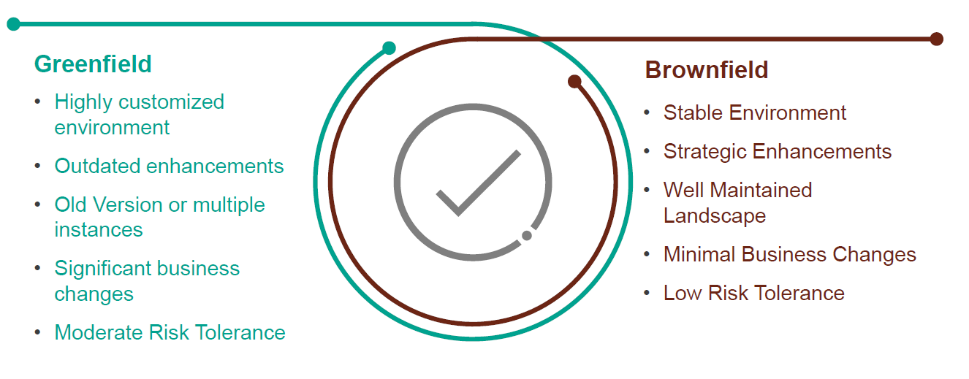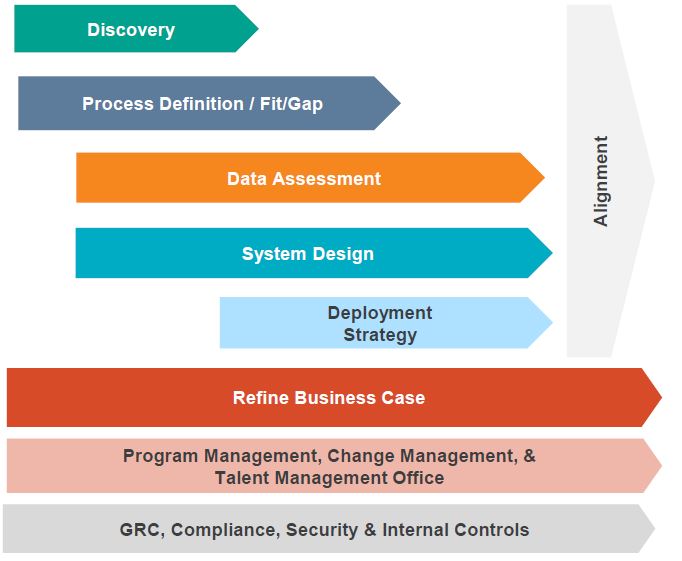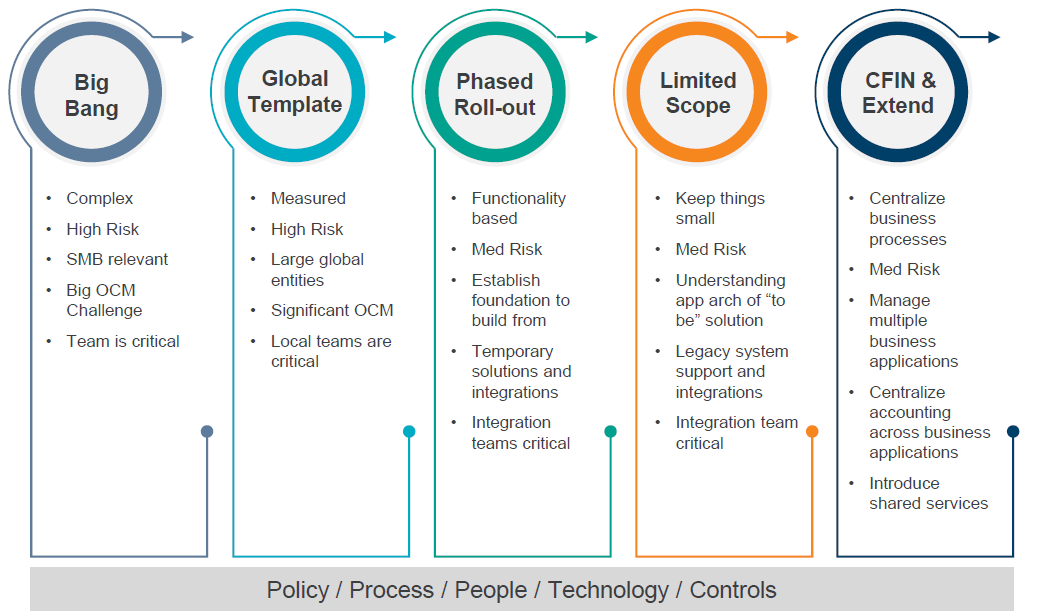A project must start somewhere. And the best place is right here. Phase Zero, or the very foundational steps an organization would take to begin its journey to a successful implementation of SAP S/4HANA. In this post, we will focus on the processes before implementation and early stage management and governance, looking at the various approaches and key areas that all companies should consider as they begin their journey.
One of the initial steps in Phase Zero is determining whether the organization will take a greenfield, or new implementation, approach or whether a brownfield, or system conversion, approach. Both are completely different paths to complete your S/4HANA journey. Organizations that select a greenfield conversion are often moving from a highly customized environment that has likely become more complex over the years, to a simpler more standard environment. A greenfield implementation is typically model company driven. Here, we see data as being one of the critical components, even if the organization is moving from an older SAP solution. Data and data structures in S/4HANA change a bit, so there are considerations on what data to convert and whether the data structures align with future reporting needs. On the other hand, a Brownfield approach may be more appropriate for organizations that have much more stable environments. This would include organizations with enhancements that are strategic and still working within very well-maintained landscapes, businesses that have stayed relatively consistent or systems that have been managed well through change, or that simply have a low risk tolerance. Having said that, there may still be a need to revisit master data, since S/4HANA has changes to some of the master data structures, e.g., GL account master data, business partners, etc.

We should point out that, during a recent webinar we conducted on this topic, we polled our audience as to where they are on their S/4HANA journey. Almost half had not yet started or have no plans in place. A third of the remaining attendees are just now starting to develop their strategy and implementation plans. So, if you have not yet considered a Phase Zero effort, you are not alone. With that said, 2025 will be here before we know it, so now is the perfect time to begin planning.
The Phase Zero Approach
Rather than jumping right into the project and beginning system setup and design sessions, our Phase Zero approach starts with the old adage “measure twice and cut once.” We focus on identifying data sources and quality, confirming scope, determining whether we are looking for business transformation or merely a system conversion or something in between, and developing a business case and deployment approach that meets the organization’s needs.

Phase Zero typically includes the key workstreams illustrated in this chart (above), that deliver a solution design and roadmap to help organizations execute their SAP S/4HANA initiative, with a strong focus on achieving desired outcomes and managing both program effectiveness and associated risk. Phase Zero should focus on business processes, system design, data, and the deployment strategy. The outputs of each workstream help to establish a plan and build alignment with key stakeholders to finalize scope, approach and the roadmap for implementation.
One of the keys here is to be able to go into an implementation very well organized, and very well structured for success. The idea behind this approach is really to focus on the areas that are often left behind in projects, or that do not get the right focus once a project is in flight. When we talk about pulling data into a Phase Zero, this really helps to align not just around the data conversion and migration but also the reporting strategy and what the data structures need to look like to support the future desired reporting strategy.
Security, internal controls and compliance issues are additional areas that, in the heat of battle of implementations, tend to get left behind. The idea of including these areas, even though not necessarily a deep dive, is to make sure there is ample consideration given to the work stream and that the organization is set up to go live with security and internal controls that work. Without this consideration many organizations end up having to come back after go-live and make additional (and sometimes substantial) investments to try to remediate these areas.
It’s All About the Data
We cannot emphasize enough how important it is to understand the current state of your data well before getting to the data migration stage of the project. From both our experience and various surveys, it has become clear data has had a significant impact on the timeline of S/4 implementations. In Phase Zero, we emphasize that there is no better time than NOW to start getting data organized. As part of this process you should ask: What data are we using? What state is it in – how clean is the data? How much history do we have/need? Organizations should also look at their analytics and reporting needs, reviewing both current reports and issues with those reports as well as what future reporting needs might be. This is a great opportunity to clean up customers, vendors and materials that are no longer active and to archive that data so the migration will only involve what is needed and relevant.
This is specifically relevant for vendor and customer master records as the structures for these have changed in SAP S/4HANA. With the potential for multiple addresses and roles for Ship To, Sold To, Alternate Payee, Payee on Behalf Of, Head-Office, Branch-Office, etc…, and the additional complexity of often dealing with multiple source systems, spending adequate time to identify the scope of effort up front is critical before embarking on the S/4HANA journey.
Often, we see companies that have tried to address these areas during the project, and there is rarely enough bandwidth or time to do adequate data cleansing and archiving. As a result, they end up spending additional time working on data that is no longer needed or going live with data issues that cause significant problems once the new system goes live. This is also an opportunity to make changes to data for reporting purposes, for example with the move to business partner functionality for the customer master, we have seen clients that have fixed problems from their original implementation with how “sold to” and “ship to” relationships were defined. As a result, they had much better visibility into their customers and a simplified sales process.
The Right Deployment Strategy
There’s a lot of ground to cover and a lot of areas to review in Phase Zero. However, once this analysis, planning and foundational work has been completed, the next step is to determine which deployment strategy will be the best fit. We do not see many “big bang” deployments these days, as they are complex and high risk, and most organizations select a more moderate path. Many organizations opt for strategies like establishing a global template and then rolling out by business unit, or a phased roll-out focused on getting the core functionality in and then expanding the functional footprint once they are live.

Phase Zero is critical as it helps clarify and define scope, resource needs, the business case and, ultimately, the deployment strategy, which sets the organization on the road to success.
Let’s circle back to the old adage: Measure twice and cut once. We feel that is an excellent way to begin the SAP S/4HANA journey. Determine the organization’s risk tolerance. Leverage model company and standard functionality where possible to minimize enhancements and reduce risk. Start evaluating data now. Get governance models set early. Commit the right resources. And the organization will be well on the way to getting the S/4 journey started.
To listen to the entire SAP S/4HANA webinar series, click here. Visit Protiviti’s SAP consulting services page for more information on our solutions.






